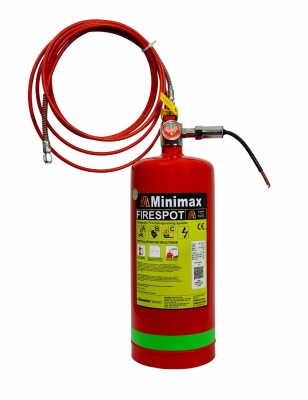FIRESPOT® Room Protection System

| Specifications | 10 kg |
| Working Temperature °C | -30 °C to +60 °C |
| Burst Pressure | 55/80 bar min., 110 bar (actual) approx |
| Cylinder Testing Pressure | 35 bar for 30 sec. |
| Operating Pressure | 8 bar |
| Propellant | Dry Nitrogen |
| Charge | Grenoz® 1230 / FK 5-1-12 (UL approved Clean Agent) |
| Accessories | Gas Release Panel, GSM Dialler, Audio Visual Hooter |
| System Approval | National Test House, Govt. of India Laboratory |
Minimax FIRESPOT® Room Protection System is a suppression solution designed for unmanned rooms where manual intervention at early stages of fire is not possible. This automatically operating suppression system is ideally suited for small server rooms and storage areas where special attention is required in providing adequate protection against fire hazard with early detection and suppression without causing any collateral damage.
This system comprises of ceiling mounted cylinder filled with Clean Agent and integrated with an electrically actuated control valve, point detectors and Fire Detection and Alarm panel. In case of fire, the detector sends signal to the fire alarm panel, which triggers the electrical actuator on the cylinder valve to discharge the agent into the room thereby suppressing the fire. An optional GSM dialer enables a signal to be sent alerting users by an SMS message on their mobile phones in the event of a cylinder being actuated due to fire.
FIRESPOT® Room Protection System is the most effective and reliable product for protection of small rooms or cabins. The system is approved by National Test House, Central Govt. testing Laboratory of India.
This system is best suited for electrical panel rooms, UPS and battery rooms, switchboard, record and server rooms etc.
Look For More
FAQ's
- Class A, B and C Fire Hazard – Fire Extinguisher within 15 m travel distance.
- Class D, F and Special Fire Hazard – Fire extinguisher within 10 m travel distance.





